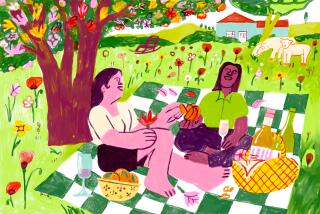The Fighting Varietals
- Share via
One of the biggest wine niches, the fighting varietals, is getting bigger. Including wines priced from roughly $5 to $7, this group is a step above jug wines and just below the lower-priced estate-bottled varietals. Traditionally, these wines have come from California and, for the past few years, Chile and Australia. Now wines from the south of France and South Africa are joining the crowd.
All of this adds up to a projected 400,000 new cases of wine in the American market next year--roughly the equivalent of adding a new winery the size of Wente Bros.
The greatest impact in the United States may well be from the Languedoc-Roussillon area of France, an enormous wine-growing region that stretches from the Spanish border all the way to the Rhone and produces two of every five bottles made in France.
In the past this was the jug wine capital of Europe and most of its wines were extremely modest. But recently, finer grape varieties have been planted, more modern technology has been used, and the wine has gone from dull to drinkable.
The amount of acreage involved is truly extraordinary. Robert Skalli, owner of one of the largest food firms in France, says his company has agreements with 150 growers to buy the grapes from 17,000 acres of vineyards--the equivalent of half the total of Sonoma County--from the Pays d’Oc region of the Languedoc.
Skalli’s new, massive winery in Sete already turns out 3 million cases of wine, a third of it marketed under the name Fortant de France. In the United States, the wines are priced at $7 or less, a few below $5.
The best wine in the Fortant line is probably the 1992 Sauvignon Blanc ($6) with a delicate varietal aroma of hay and grapefruit. The 1992 Chardonnay ($6) also is attractive, with a light fragrant note of apples and a clean finish. The red wines are well made but not as interesting; the 1992 Cabernet was better than a 1992 Syrah.
Joining Skalli is another Pays d’Oc vintner, which sells its wines under the label Chantfleur. I was impressed with the 1992 Chantfleur Chardonnay. It has sprightly fruit (spicy apple and pear) and a crisp finish. Its price, $4.50 a bottle, is a good value.
The push for South African wines here is being made in anticipation of a black-majority-rule government taking over in South Africa next spring. The South African government has set April 27, 1994, as the tentative date to hold the first multiracial election in the nation’s 350-year history. Ken Onish set up his company in 1992--six months after the lifting of trade sanctions against South Africa--to import South African wines into the United States.
Onish’s wines are all made by a large cooperative located just south of Cape Town. Its Springbok line (created expressly for the U.S. market) includes an attractive 1991 Chardonnay ($6) with a creamy texture and light but tasty flavors.
The best wines Onish makes are sold under the names Cathedral Cellars, Backsberg and Niel Ellis. The 1990 Cathedral Cellars Cabernet Sauvignon ($13) will be served when Nelson R. Mandela and South African President F. W. de Klerk receive the Philadelphia Liberty Medal from President Clinton on July 4.
The Pinotage grape, a cross between Pinot Noir and Cinsault, is unique to South Africa, and Onish is marketing a 1990 Backsberg Estate Pinotage at $8 that is very tasty and smooth. The company also is known for its Ports and Sherries, and the line includes a range of those, all reasonably priced.
Another line of South African wines, the Bergkelder Collection, is being imported by Roederer, the French Champagne producer. This broad line of wines is priced higher ($10 to $18) and includes a dozen brand names, including Meerlust, La Motte, Stellenryck and L’Ormarins.
The best of the line are a 1986 Meerlust Cabernet ($17) and 1987 Meerlust Rubicon ($17), a Cabernet blend. I also like the minty, richly flavored 1988 Stellenryck Cabernet ($14), but the market may not be ready for South African wines at these prices.
Wine of the Week
1989 Louis M. Martini Winery Zinfandel ($7) --This old-line Napa Valley producer has a long and distinguished track record with red wines, especially Zinfandel. The winery’s 1989, a blend of grapes from Sonoma and Napa, is a handsomely crafted lighter-styled wine with ample fruit and tartness to match a variety of foods. Serve it slightly cool (not chilled) to appreciate the bright fruit and tart finish.
More to Read
Eat your way across L.A.
Get our weekly Tasting Notes newsletter for reviews, news and more.
You may occasionally receive promotional content from the Los Angeles Times.










